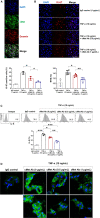Urinary cMet as a prognostic marker in immunoglobulin A nephropathy
- PMID: 32822114
- PMCID: PMC7576300
- DOI: 10.1111/jcmm.15636
Urinary cMet as a prognostic marker in immunoglobulin A nephropathy
Abstract
The prediction of prognosis in patients with immunoglobulin A nephropathy (IgAN) is challenging. We investigated the correlation between urinary cMet (ucMet) levels and clinical parameters and examined the effects of cMet agonistic antibody (cMet Ab) in an in vitro IgAN model. Patients diagnosed with IgAN (n = 194) were divided into three groups representing undetectable (Group 1), below-median (Group 2) and above-median (Group 3) levels of ucMet/creatinine (ucMet/Cr). Stained kidney biopsy samples were graded according to cMet intensity. Primary-cultured human mesangial cells were stimulated with recombinant tumour necrosis factor (TNF)-α and treated with cMet Ab. Our results showed that ucMet/Cr levels positively correlated with proteinuria (P < .001). During the follow-up, patients in Group 3 showed a significantly lower probability of complete remission (CR; uPCr < 300 mg/g) than those in groups 1 and 2, after adjusting for blood pressure, estimated glomerular filtration rate, and proteinuria, which influence clinical prognosis (HR 0.60, P = .038); moreover, ucMet/Cr levels were also associated with glomerular cMet expression. After TNF-α treatment, the proliferation of mesangial cells and increased interleukin-8 and intercellular adhesion molecule-1 expression were markedly reduced by cMet Ab in vitro. In conclusion, ucMet/Cr levels significantly correlated with proteinuria, glomerular cMet expression, and the probability of CR. Further, cMet Ab treatment alleviated the inflammation and proliferation of mesangial cells. Hence, ucMet could serve as a clinically significant marker for treating IgAN.
Keywords: cMet agonistic antibody; complete remission; immunoglobulin A nephropathy; inflammation; mesangial cells; prognostic marker; proliferation; proteinuria; urinary cMet.
© 2020 The Authors. Journal of Cellular and Molecular Medicine published by Foundation for Cellular and Molecular Medicine and John Wiley & Sons Ltd.
Conflict of interest statement
The authors confirm that there are no conflicts of interest.
Figures




Similar articles
-
Soluble cMet levels in urine are a significant prognostic biomarker for diabetic nephropathy.Sci Rep. 2018 Aug 24;8(1):12738. doi: 10.1038/s41598-018-31121-1. Sci Rep. 2018. PMID: 30143691 Free PMC article.
-
Urinary excretion of β2-microglobulin as a prognostic marker in immunoglobulin A nephropathy.Korean J Intern Med. 2014 May;29(3):334-40. doi: 10.3904/kjim.2014.29.3.334. Epub 2014 Apr 29. Korean J Intern Med. 2014. PMID: 24851068 Free PMC article.
-
High urinary excretion of kidney injury molecule-1 is an independent predictor of end-stage renal disease in patients with IgA nephropathy.Nephrol Dial Transplant. 2011 Nov;26(11):3581-8. doi: 10.1093/ndt/gfr135. Epub 2011 Apr 5. Nephrol Dial Transplant. 2011. PMID: 21467131
-
Factors predicting progression of IgA nephropathies.J Nephrol. 2005 Sep-Oct;18(5):503-12. J Nephrol. 2005. PMID: 16299675 Review.
-
Proliferative glomerulonephritis with monoclonal immunoglobulin G deposits complicated by immunoglobulin A nephropathy in the renal allograft.Nephrology (Carlton). 2016 Jul;21 Suppl 1:48-52. doi: 10.1111/nep.12775. Nephrology (Carlton). 2016. PMID: 26971743 Review.
Cited by
-
Exploring the molecular mechanism of budesonide enteric capsules in the treatment of IgA nephropathy based on bioinformatics.Sci Rep. 2025 Aug 21;15(1):30795. doi: 10.1038/s41598-025-16380-z. Sci Rep. 2025. PMID: 40841751 Free PMC article.
-
Hepatocyte growth factor and soluble cMet levels in plasma are prognostic biomarkers of mortality in patients with severe acute kidney injury.Kidney Res Clin Pract. 2021 Dec;40(4):596-610. doi: 10.23876/j.krcp.20.258. Epub 2021 Sep 10. Kidney Res Clin Pract. 2021. PMID: 34510856 Free PMC article.
-
Kidney diseases and long non-coding RNAs in the limelight.Front Physiol. 2022 Oct 10;13:932693. doi: 10.3389/fphys.2022.932693. eCollection 2022. Front Physiol. 2022. PMID: 36299256 Free PMC article. Review.
References
-
- Wyatt RJ, Julian BA. IgA nephropathy. N Engl J Med. 2013;368:2402‐2414. - PubMed
-
- Nair R, Walker PD. Is IgA nephropathy the commonest primary glomerulopathy among young adults in the USA? Kidney Int. 2006;69:1455‐1458. - PubMed
-
- Lee H, Kim DK, Oh KH, et al. Mortality and renal outcome of primary glomerulonephritis in Korea: observation in 1,943 biopsied cases. Am J Nephrol. 2013;37:74‐83. - PubMed
-
- D'Amico G. The commonest glomerulonephritis in the world: IgA nephropathy. Q J Med. 1987;64:709‐727. - PubMed
-
- Chang JH, Kim DK, Kim HW, et al. Changing prevalence of glomerular diseases in Korean adults: a review of 20 years of experience. Nephrol Dial Transplant. 2009;24:2406‐2410. - PubMed
Publication types
MeSH terms
Substances
LinkOut - more resources
Full Text Sources
Miscellaneous

